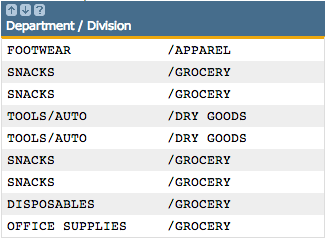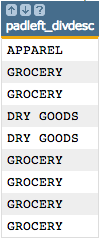padleft(X;Y)
Returns the given string with a certain number of characters, adding blanks at the beginning if necessary.
Syntax
padleft(X;Y)Input
| Argument | Type | Description |
|---|---|---|
X |
text | The string on which to apply the function A scalar value or the name of a column |
Y |
integer | The number of characters of the resultant string |
Return Value
Returns the text string from the end of X up to the number of characters
specified by Y. If Y is greater than the length of
X, blanks are added to the beginning of the resultant string.
If X is N/A, the result is a string consisting of Y blank
characters.
Sample Usage
value |
length |
padleft(value;length) |
|---|---|---|
| 'banana' | 4 | 'nana' |
| 'banana' | 10 | 'banana' |
Example
In the example for padright(X;Y), we
used the "Product Master" table (pub.demo.retail.prod) to demonstrate
how we could add padding to the department descriptions to help align the division
descriptions in a computed column we created. We used Macro Language similar to the
following.
<base table="pub.demo.retail.prod"/> <willbe name="padright_dept" value="padright(deptdesc;20)"/> <willbe name="padright_result" label="Department / Division" value="splice(padright_dept divdesc;'/')" format="width:40"/>
which resulted in a column that looked like:

But what if we wanted to add space before the division descriptions so that they appeared
right-justified after the slashes ("/"), resulting in a column that looked
something like:
FOOTWEAR / APPAREL SNACKS / GROCERY SNACKS / GROCERY TOOLS/AUTO / DRY GOODS TOOLS/AUTO / DRY GOODS
We could use padleft(X;Y) to add padding to the beginning of the division
descriptions so that they are all the same length.
For our example, let's make all the division descriptions 15 characters in length. To do
this, create a computed column and apply padleft(X;Y) to the
divdesc column and specify 15 for the
Y parameter:
<willbe name="padleft_divdesc" value="padleft(divdesc;15)"/>
This creates a new column whose division description values are all 15 characters in length, with extra blank spaces added to the beginning of those values that are less than 15 characters:

Now, we can create a new computed column using the splice(X;Y) function
again, but this time we will specify the new padleft_divdesc column instead
of the divdesc column in the list for the X parameter so
that we get the padded strings:
<willbe name="padleft_result" label="Department / Division" value="splice(padright_dept padleft_divdesc;'/')" format="width:40"/>
width to <willbe> so
that the column width will accommodate the larger string length.This results in a column that looks like:

Now, each division description is 15 characters in length, following the slash, and is padded on the left with blanks.
Additional Information
- This function does not work with Unicode (UTF-8) strings.
- For a Unicode-compliant alternative, consider
strembed(X;N;P;Y;D).
